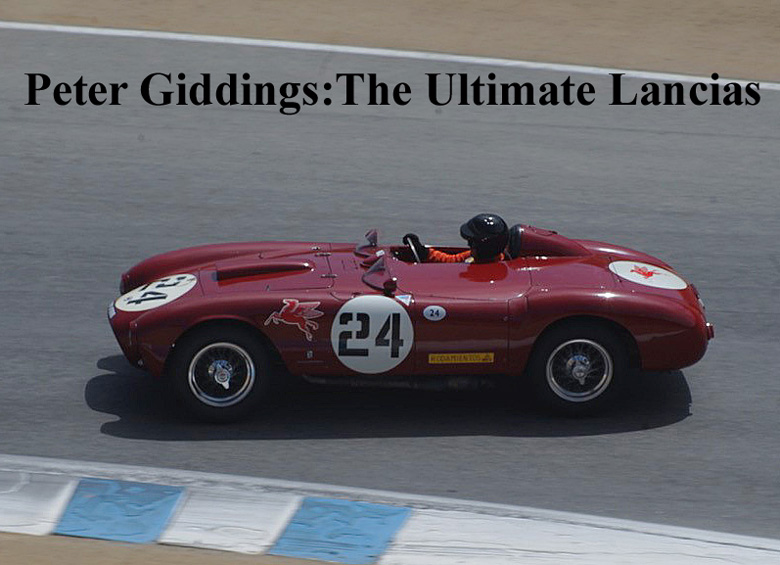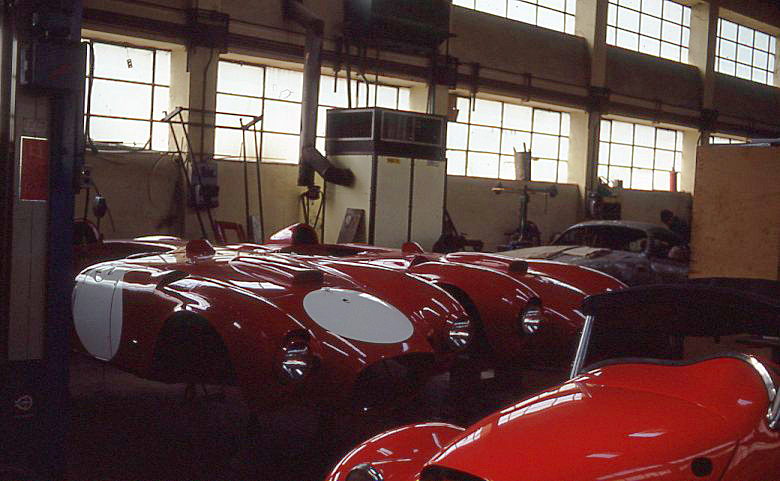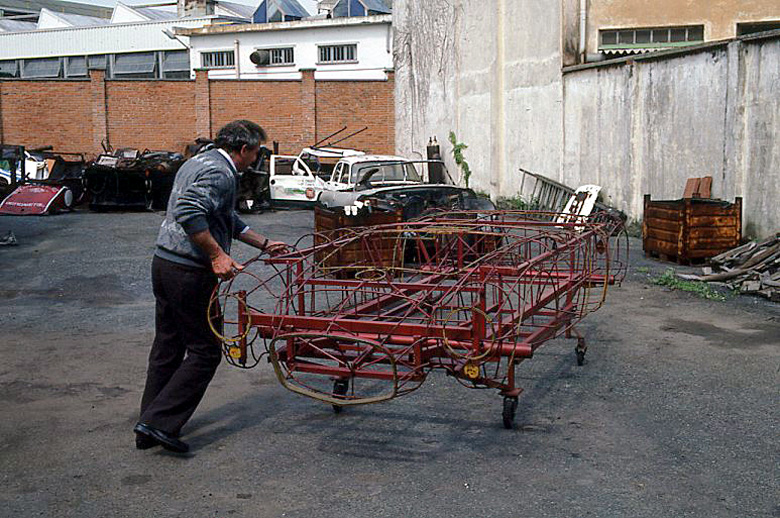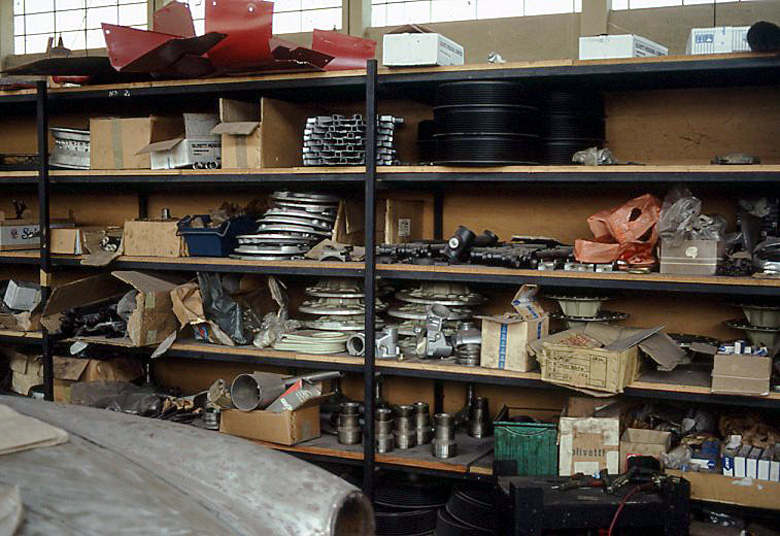Story by Brandes Elitch
Photos by Steve Snyder
It would be difficult if not impossible to find a more compelling story than that of Peter Giddings. In his youth in England, he restored a BSA three-wheeler, then a Brooklands Riley 9, and then a chain drive Frazer Nash, which he rebuilt in his living room (I say “restored” because owning these cars in England in the sixties would require continuous attention just to keep them running). He started racing the Frazer Nash in 1959, and competed in virtually every race circuit and hillclimb in England, earning his full FIA International racing license in 1961. In 1985, he raced his Alfa Romeo Monza and his P3 Alfa Scuderia Ferrari Tipo B at the Monterey Historics, and was awarded the Phil Hill trophy.
Peter has won more historic racing events in his Alfas than anyone else in the world. He has rebuilt and supervised restorations of a 1924 Lyons GP Bugatti, several Monza Alfas, two Talbot Lago GP cars, two supercharged eight-cylinder Alfa P3s, two Alfa 8 C 35s, a Bugatti type 59, and an 8CM and 250F Maserati. He has been awarded the title of “Grand Master” for his performance in the North America Ferrari-Maserati Challenge, a title he shares with only one other individual.
Giddings grew up in England, close to the famous Brooklands racetrack. As a youth, he was caught numerous times sneaking in under the fence. One day, to quote from a recent interview published in the 2018 Danville Concours Official Program, his mum got a visit from a track official, who said, “We shall come up with a way for him to come through the gate, and we will put him to work as a timekeeper’s spotter, and we will supply him with a boxed lunch!” I can scarcely imagine a better start to a life in cars than this. As he says, he was an incredibly lucky young man who lived at the right time, when you could purchase an Alfa 8c for a few hundred dollars!
Today he owns a Lancia D 50R and a D 24/5R*, a Lancia Lambda, the aforementioned Alfas, a few Bugattis, and what he considers his favorite: the 1926 Delage 15-S-8, driven in period by Richard Seaman. When asked about his fantasy dream competition, he mentions Moss in a 250F, Fangio in a D 50, Whitney Straight in an 8CM Maserati, Phil Hill driving his Talbot Lago 26C, Nuvolari in an Alfa P3, and curiously, a London used car dealer named Dan Margulies, driving an 8 CM. This surprised me because in 1966 I purchased a Lagonda V12 sports saloon with H.J. Mulliner coachwork (chassis 16041/ engine number 89) from Dan Margulies, who as it turns out is characterized by Giddings as “about the only honest London dealer in exotic and pre-war cars at the time.”
Commenting on his prewar Alfas, he says, “The reason for my love of the pre-war Alfa is because they were the brilliant designs and vision of Vittorio Jano.” During the thirties, Jano was tasked at Alfa with building world class racecars on a shoestring budget, to compete with the Mercedes and Auto Unions which were backed with unlimited funding by the Third Reich. At some point, Jano left where he fortuitously ended up at Lancia.
Lancia Sports and Grand Prix cars
In 1950, Lancia introduced the Aurelia B10 sedan, with a V6 motor and rear-mounted clutch and gearbox, and fully independent suspension, very advanced for its time. In the 1951 Mille Miglia an Aurelia coupe, driven by Bracco and Maglioli, came in second to a 4.1 liter Ferrari. Lancia won the 1952 Targa Florio in the a more powerful version of the Aurelia coupe. Gianni Lancia, the son of the founder, believed that success in racing would improve sales and profits, so in 1953 a factory competition department was formed, under Jano’s leadership. The initial work produced the D 20 and D 23, and in 1954, the D 24. This had a steel tubular frame, aluminum Pinin Farina coachwork, large front and rear inboard brakes, a DOHC 3.3 liter motor, and a five-speed rear mounted transaxle. The suspension had leaf springs with a de Dion tube, giving excellent weight distribution and a low unsprung weight. In 1953, Lancia achieved a 1-2-3 win in the Carrera Pan Americana (Fangio, Taruffi, and Castellotti), followed by Taruffi winning the Targa Florio. Lancia again won the Targa in 1954 and the Mille Miglia. In 1954, the factory switched their racing focus from road racing to Grand Prix racing, which led to the famous D 50. However, financial issues, and the death of Ascari in 1955 led to the closure of the racing department.
Space does not permit a full accounting here of the D 50, but Chris Nixon has written an entire book about it, called “Rivals” about its rivalry with the Mercedes W 196. Interestingly, there were rumors that Mercedes was interested in buying the D 50s in 1955 and destroying them to ensure the success of its own W 196. Hearing this rumor, the Italian Automobile club suggested that the assets of the Lancia Competition Department be turned over to Ferrari. Ferrari was too proud to go along with this idea, but he was undoubtedly prompted off his throne by the promise of a stipend of fifty million lire annually from FIAT for the next five years! In 1956, Fangio won his fourth World Driver’s Championship at the wheel of a “Lancia-Ferrari” D 50.
Guido Rosani and Luciano Basso
The story takes a strange turn here, when the Lancia Board of Directors, no doubt fed up with Gianni, dictated that all but two of the original D 24s and two of the D 50s be broken up and destroyed. However, here is where fate intervened. The destruction was witnessed by a young man who was the son of one of the Directors, one Guido Rosani. It haunted him, and many years later, in the 1980s, with the help of Luciano Basso and the unofficial support of the Lancia Museo, Rosani commenced an unbelievable project: to actually recreate four D 24s and also four D 50s, using the original Lancia drawings and the original racing engines and other party that had somehow been rescued from the carnage. The four recreations have been in long-term private ownership; Giddings being one of the fortunate few, has one of both. The two original D 24s survive, one in the Lancia Museo and the other, originally a gift from Lancia to Juan and Eva Peron in Argentina, was restored by Count Vittorio Zanon.
Back to Rosani, who by 1994 had built a new D 50 chassis by hand, complete with an original D 50 motor. He was missing the intricate transaxle, but fortunately was helped by one Anthony Maclean, who introduced him to Anthony Bamford in England, and the three of them agreed on a plan to build four cars in Torino and then ship them to England, where Jim Stokes would rebuild the engines and transaxles and prepare the cars to be race-worthy. Many people were involved in the complicated and painstaking process of procuring original parts and drawings, recreating obscure parts made of unobtanium, and there is a wonderful story here. One day, someone wandered into Guido’s office with about 17 of the missing and rare Solex carburettors. Then, two engines magically appeared in Italy. A third motor surfaced which was originally given to the owner in 1955 by Gianni Lancia for a powerboat, still in the original crate and never unpacked! Ironically, the four reconstructed D 50s have more original parts and are closer to their original specification than most of the Maserati 250Fs still racing.
The Giddings Lancias
Giddings lives in Northern California, near both the Sears Point and Laguna Seca racetracks, where he has competed successfully so many years. Last month we had another Historic Racing event here at Sears Point, and Giddings D 24R was driven by another legend: Lyn St. James.
Although retired from the professional racecar circuit since 2001, she is still actively involved in the sport. She competed in the IndyCar series, with eleven CART and five Indy Racing League starts, and is one of only nine women to have qualified for the Indianapolis 500. She was the first woman to win the Indianapolis 500 Rookie of the Year award, and has two victories at the 24 Hours of Daytona and one win at the 12 Hours of Sebring. She has raced at the 24 Hours of Le Mans and the 24 Hours of Nurburgring. Sports Illustrated magazine has counted her as one of the top 100 women athletes of the 20th Century.

Lyn St. James at turn 10 at Sonoma Raceway, CSRG on 6 Oct 2018, driving Peter Giddings’ Lancia D 24R.
However, what I found particularly interesting is that she has a piano teaching certificate from the St. Louis Institute of Music! Our photographer Steve Snyder was there to capture her with Giddings, a truly special moment for both, I would imagine. Thanks to Steve for suggesting this story for our readers.

Peter with Alma Hill, Phil Hill’s widow at the Danville, Ca. d’Elegance car event discussing old times.
Thanks to Peter Giddings for playing such an instrumental role in the preservation of both a D 24 and a D 50, truly among the absolute greatest racing cars ever built.
*Peter defines his car as a D 24/5 (has a D 25 engine). His chassis no. is D 24/5R #0002 fitted with engine D 25#0001.








Two of my all time favourite race cars. Models of each take pride of place in my scale model collection. Thanks for the story.
Beautiful body design … who was the designer?
Great story and great cars. I was lucky to have seen and hear one of the replica D50’s driven by Jochen Mass during a Goodwood revival meeting. fantastic car.
I know Luciano Basso also recreated the B20 da Corsa. The lightweight version of the B20 coupe that ended up 2nd in the 1951 Mille Millia as was mentioned in this article. This small batch of special aluminium bodied B20’s participated in the MM of 1952 and beyond untill the D20/23/24 and 25 series cars took over. This is my all time favourite lancia of all time and I would love to read the story of their recreation by Luciano Basso.
It is wonderful to see Peter . I recall him being here to run at the Philip Island Classic in 2003 a true Gentleman Driver.
Jim
Peter is truly the soul of pre-war vintage car racing.
Bringing the very best cars of that era to our events and driving them with the verve of Nuvolari and Ascari.
Peter, without you we could never have imagined that era.
The D24 that Count Vittorio Zanon restored in Italy, where is this car now located?
“The story takes a strange turn here, when the Lancia Board of Directors, no doubt fed up with Gianni, dictated that all but two of the original D 24s and two of the D 50s be broken up and destroyed. However, here is where fate intervened. The destruction was witnessed by a young man who was the son of one of the Directors, one Guido Rosani. It haunted him.”
In fact that turn sounds a little too strange to be true. Ascari’s death, in testing after Monaco in 1955, hit Gianni Lancia hard, and he stopped all racing activity. Lancia offered the D50s to Maserati, who turned them down; they already had the successful 250F. At the suggestion of the ACI, for the ‘good of Italian motorsport’, Lancia ended up giving the D50s to Ferrari, who had been struggling with their Super Squalo. So in mid-1955, along with a lot spares, 6 D50s were transferred to Ferrari. This is well documented in Nixon.
Hi Pete:
I have photos of both the Giddings Formula One Lancia taken at St Jovite Quebec in 2016 and the D24 taken last year at the Glen vintage weekend. Would you like copies of the photos?
John R. Wright
Peter Giddings raced his Alfa at the Portland track several summers, and I spoke briefly to him many times. Those were the days when we had Indy cars at our track as well (recently reintroduced) and I still have a jacket with Lyn St James’ autograph on it. What wonderful days.
Nice article! Peter purchased a disassembled Stanguellini Formula Junior from me in the 70s. I wonder what ever happened to that car?
I’ve raced with Peter, and he is A role model as an owner and cometitor. It is a shame about Peter’s health lately, and I’m sure I speak for everyone in wishing him the best of uck.